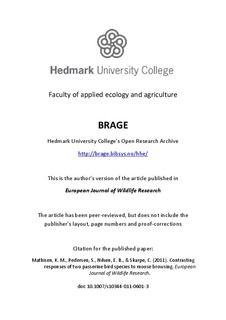Contrasting responses of two passerine bird species to moose browsing
Journal article, Peer reviewed
Permanent lenke
http://hdl.handle.net/11250/134470Utgivelsesdato
2012Metadata
Vis full innførselSamlinger
Originalversjon
Mathisen, K. M., Pedersen, S., Nilsen, E. B., & Skarpe, C. (2011). Contrasting responses of two passerine bird species to moose browsing. European Journal of Wildlife Research, 58(3), 535-547. doi: 10.1007/s10344-011-0601-3 http://dx.doi.org/10.1007/s10344-011-0601-3Sammendrag
Large herbivores may modify the ecosystem in a way that affects habitat quality and resource availability for
other fauna. The increase in wild ungulate abundance in many areas may therefore lead to ecosystem changes,
affecting distribution and reproduction of other species. Moose (Alces alces) in Scandinavia is a good example of
a herbivore that has recently increased in abundance, and has the potential to affect the ecosystem. In this study
we investigated how different levels of moose winter activity around supplementary feeding stations for moose
affect reproduction in two insectivorous passerines: great tits (Parus major) and pied flycatchers (Ficedula
hypoleuca). The two bird species showed contrasting responses to high moose activity at feeding stations. Great
tits avoided habitats with high moose activity, where fledging success and feeding frequency was lower than at
low moose activity habitats. Flycatchers nested more often at high moose activity habitats where fledging weight
and feeding frequency were higher than at low moose activity habitats. Filming of nest boxes with great tits
showed an increase in adult Lepidoptera in the diet at supplementary feeding stations for moose, and a smaller
size of caterpillar prey at intermediate moose activity. The results support the hypothesis that herbivores may
affect insectivorous passerines through changed arthropod food availability.
Beskrivelse
This is the postprint version of the article. The original publication is available at www.springerlink.com
